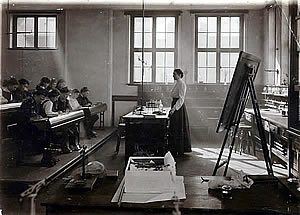|
| |
In the early
years, the
youngest
children did "a little
nature work and
elementary
botany",
and the older
girls did two
years' study of
each science in
turn, physics
followed by
chemistry,
followed by
biology.
Girls in the
Sixth Form could
study any or all
of the Sciences,
but were not
always
adequately
grounded for
advanced study.
This was the
situation until
World War
II.
|
|
|
|
|
| |
"It is
satisfactory to find
that a substantial
subject like
chemistry is given
priority in the
science course. This
is the main subject
taught, and it is
taken by a
substantial number
of the older girls.
The weaker vessels
take botany instead.
There is a
preliminary course
of Physics for
all."
From the report
of the 1922
inspection
|
|
|
|
|
| |
There is little
advanced work in the
sixth form.
"
From the report
of the 1933
inspection
|
|
|
|
|
| |
"Conditions for
the teaching of
science are not as
good as they might
be and at present
some lessons are
held in ordinary
classrooms"
From the report
of the 1949
inspection
|
|
|
|
|
| |
By the 1960s,
there was a
three year
general course
in science,
followed by a
two year O Level
course in the
sciences
chosen.
In the sixth form
girls can prepare
for A level in
chemistry, physics,
botany and zoology
and they are
particularly
successful in the
biological
sciences."
From the report
of the 1960
inspection
|
|
|
|
|
|
|
|
|
|
The school
started off with
one rather small
laboratory,
which is now
room 13.
This was
remedied in 1908
with the
building of the 'beautiful new
laboratory'
on the top of
the building -
now M11.

A science
lesson in the
1908
laboratory
In 1926 the new
laboratory,
which is now the
science room was
built. This was
the biology
laboratory,
until 1976, and
the 1908 one was
used for both
Physics and
Chemistry.
"The
chemical
laboratory is
fitted for 24
girls but it is
an awkward shape
for practical
work and also
has to be used
as a classroom.
One side
contains raised
benches, but the
demonstration
bench facing
them is not
really
adequate."
from the report
of the 1933
inspection
It was not
until 1957 that
the school got a
new laboratory,
above the girls'
dining room.
This was for
chemistry, and
at last there
was one
laboratory for
each science.
The fact that
they were so far
apart was bad
news for their
newly-acquired
laboratory
assistant.
By 1965,
"Increasing
use was being
made of
facilities
outside the
school, the
College of
Technology
allowed members
of staff and
sixth form girls
to work with
highly
specialised
apparatus on
Saturday
mornings."
And in 1976, the new
laboratory block at
Cecil Place was
built, and the
school at last had
adequate and
convenient
laboratory
provision.
Physics
Biology
Chemistry
|
|
|
|
|
| |
After the War, until
around 1960, girls
taking Advanced
Level sciences had
to travel to London
to do their
examination
practicals.
"The train
time was never
very good, and
you know in
South Ken you
have that long
subway, well, we
had to run along
there to get to
the Examination
Boards - just
behind the
Natural History
Museum - in
time, and it was
Physics in the
morning and
Chemistry in the
afternoon. It
was very strange
going into a
strange lab.
with lots of
people around
you….you
were just
designated an
experiment to go
and do.
"
from a 1950s
pupil
Some university
interviewees also
had to do a science
practical at their
interview.
|
|
|
|
|
| |
"Miss Thorn
went on to encourage
all the hesitant to
become scientists.
She pointed out that
in the past year,
the study of science
had been assisted by
making physics,
chemistry and
biology separate
subjects on the
timetable, and by
the formation of a
science club, but
she still felt that
more girls ought to
explore the
scientific world
with courage and
enthusiasm…..
she would not,
however, attempt to
force any girl to
study science who
had made up her mind
otherwise."
From the 1958
school
magazine
|
|
|
|
|
| |
In 1967 the
Nuffield Science
syllabus was
introduced.
|
|
|
|
|
|
|





